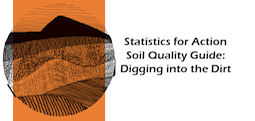For Environmental Professionals
Statistics for Action materials were designed so they could be used by community organizers with no particular scientific expertise. However, SfA can also be useful if you're an expert who struggles to explain complicated environmental situations to community members in plain language.
Use these SfA activities and resources when you meet with community groups, or send them to groups in advance, so they know what to ask when they meet with you. Many of the materials are available in Spanish as well.
A Note About Terminology
SfA materials use terms and guidelines used by the EPA and ATSDR, and sometimes a state agency. Check for differences in terms between the SfA resource and what a community will see in their own situation, and 'translate' for them. For example, they may not realize different states use "objectives," "standards," and "limits" for the same idea.
Environmental Testing Guides

The SfA environmental guides provide a 16-20 page magazine-style overview of some aspect of environmental quality management, with a focus on how communities can be involved. The Soil Quality Guide and Water Quality Guide review steps involved in site characterization and the sampling and testing processes. The Air Quality Guide covers air quality monitoring and associated regulations. The Hazardous Waste Cleanup Guide picks up where those guides leave off, with remediation options when a site is known to be dangerously contaminated. The Guide to State Cancer Profiles gives tips on navigating the CDC's web resource on state cancer data.
Video
Depending on the situation, you may find these short videos useful to send to a community before a meeting:


- What's a Liter? Parts per Million in Water
- Milligrams per Kilogram: Parts per Million in Soil
- ND = Not Detected
- Bioaccumulation and Biomagnification
- Averages Can Be Political (trihalomethanes in tap water)
- The Cost of Bottled vs. Tap Water
- Soil Contamination and Gardening
- Sampling and Testing Contaminated Soil
- Expert Advice on Health Studies
- Will the Health Study Prove Liability?
Activities, Strategies, and Fact Sheets
Leaders can suggest SfA activities to use with community groups. Learners understand more deeply and feel more empowered when they work something out for themselves, instead of being told. See our page on how to lead SfA for tips.
The activities are divided into four sections. The introduction and overview give a short summary of each activity and its scope and content.
- Understanding terms, units, and concepts in environmental data. In advance of a meeting, these activities give a group common vocabulary and ideas, and helps them identify specific questions. If you facilitate yourself, it gives a window into how you'd analyze a technical document, and helps identify gaps in their understanding.
- Analyzing data to find inconsistencies and build strategies. You might not conduct these with a group yourself... but if you have a group that's skeptical about how data is being characterized, they can use the strategies provided in these activities. If they find something alarming, they can seek your verification.
- Assessing risks to health from environmental contamination.The section overview, "Pieces of the Risk Puzzle" is an outline for making connections between environmental contamination and health problems. Send this in advance, or review it with a group. Use other activities on-demand, depending on which components of exposure or outcome the community wants to understand.
- Communicating key data to decision-makers and the community. If you're a neutral party, you may not wish to facilitate these yourself. Recommend to a group that they use these activities on their own to think about how they present their data. Once they come up with something, verify the accuracy of the characterization.
